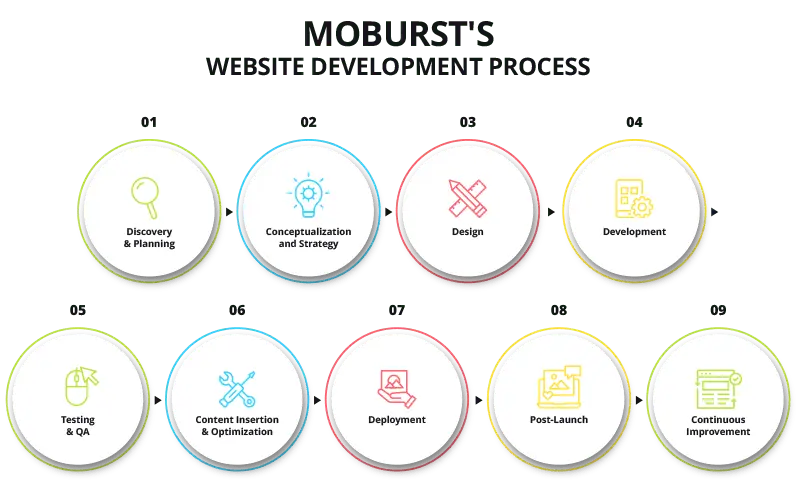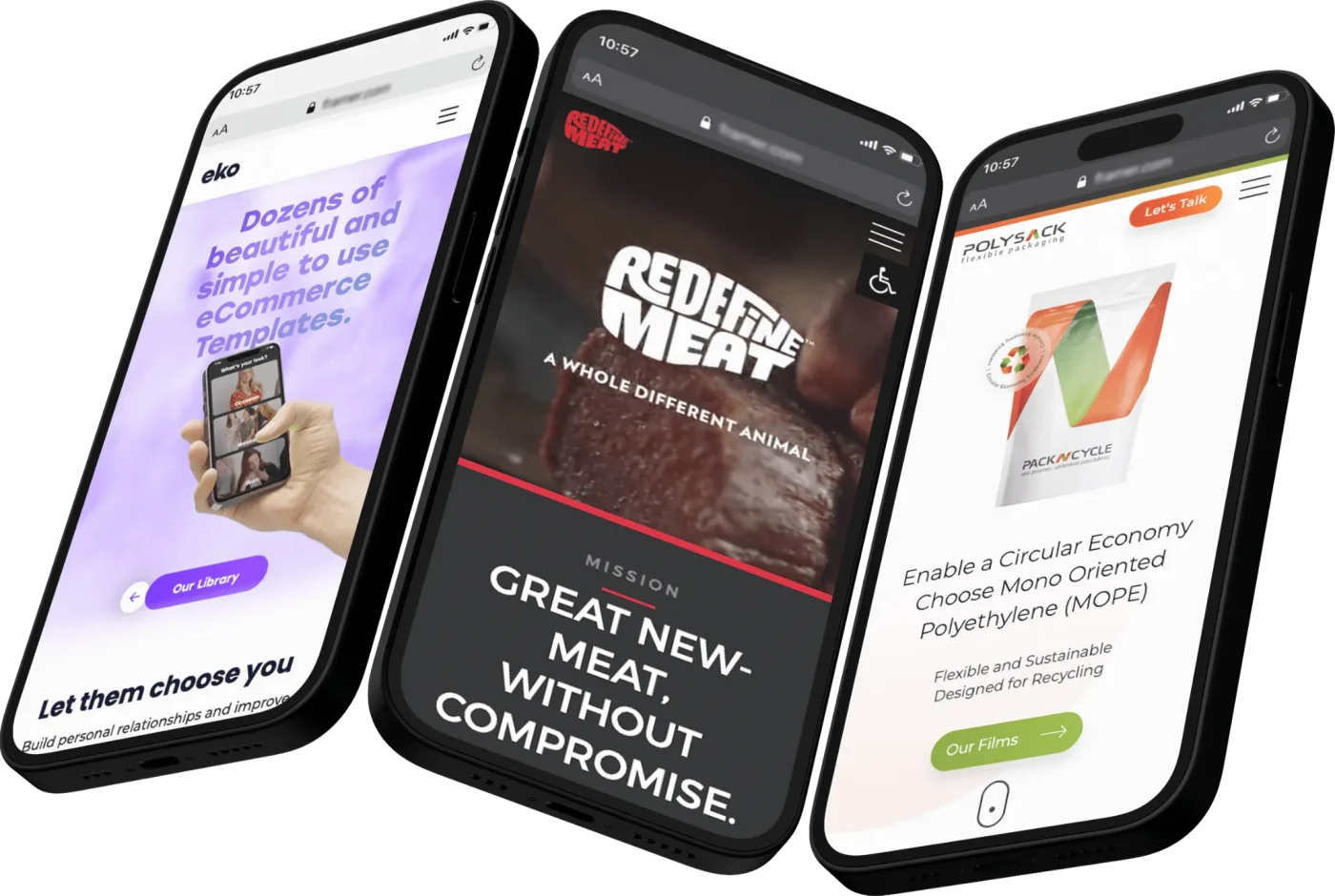Website Development Process: How Does Moburst Do it?

In today’s digital landscape, a company’s website is the cornerstone of its online presence. While marketing efforts now span a multitude of channels, everything ultimately leads back to the website—a critical hub where visitors engage with content, explore services, and seek support. For any business, understanding the website development process is essential to making informed design choices that drive engagement and achieve business goals.
Given that 88% of consumers are unlikely to return to a website after a poor experience, the stakes for website development couldn’t be higher. Performance and usability are crucial, but building a standout site requires more than just a functional design. It demands thoughtful planning, engaging content, and a strategic approach grounded in research and analytics.
In this post, we’ll walk you through Moburst’s step-by-step process for developing robust, high-quality websites that have generated incredible results for our clients.
What Is the Website Development Process?
The website development process refers to the entire series of steps taken to plan and execute a web development project, whether it’s launching a new site or redesigning an existing one. A good process should be thoroughly documented, get all involved teams and their resources into alignment, and hold the project accountable to its budget and timeline.
Typically, the process of website development will follow an outline like this:
- Definition: Determining the project’s key goals, scope, target audience, and required features.
- Discovery: Researching your market, audience, and competition.
- Strategy: Mapping out the structure, content, and flow of the website.
- Design: Choosing the look of the overall site and specific pages, creating style guides and templates.
- Development: Coding the website and its back-end software, and integrating with APIs.
- Quality Assurance: Testing the usability, performance, compatibility, and security of the website.
- Content: Creating, inserting, optimizing, and reviewing content.
- Launch: Monitoring and maintaining the live website.
- Continuous Improvement: Making necessary updates and revisions.

How Moburst Develops Award-Winning Websites
Moburst’s website development process runs through several essential steps to make sure that the final product meets the highest quality, performance, and user experience standards.
As a one-stop digital marketing agency, we leverage the experience and creative ingenuity of our specialized teams to create powerful, high-end websites.
We take into account the client’s needs, the state of the market, the competitive landscape, and the target audience’s attitudes and behavior to build websites that follow data-driven strategies to deliver measurable results.
From the first conception to the final handoff, here’s what you can expect from Moburst’s web development services.
Looking to Make Your Website Better?
Our expert team will create visually stunning and engaging websites that make a lasting impression
Discovery and Planning
In this first phase of the website building process, we gather and organize the information that will set the direction for everything that follows.
It starts with stakeholder interviews, which help us clearly understand the client’s goals, the target audience they’re trying to reach, and their business requirements. The Project Manager and the Vice President of Strategy lead these interviews.
As an example of this step, when we redesigned the website for Redefine Meat, their goal of increasing brand awareness in the four new countries where they were about to launch guided us. The discovery process gave us a clear idea of which customer segments to hyper-target (including both restaurant owners and individual consumers)—and resulted in strategies that increased engagement by over 15,000% and generated a waiting list of more than 50,000 leads.

Next, the VP of Strategy spearheads market research, analyzing current web development trends and collecting intelligence on the client’s competitors.
The Head of Research and Development will then lay out the technical requirements by defining the technology stack, determining hosting needs, and determining which third-party integrations will be utilized. This is especially important for ecommerce website development.
At this point, website cybersecurity considerations are integrated into the site’s design and architecture. This includes selecting secure technologies, establishing protocols for data protection, and defining access controls.
Finally, the project manager and VP of strategy set the scope of the project, documenting it in detail and specifying the deliverables, timeline, and budget.
| Discovery and Planning Steps | Description | Led By |
| Stakeholder Interviews | Chart a course for the project by identifying its goals, target audience, and business requirements. | Project Manager, VP of Strategy |
| Market Research | Analyze the current state of the market, emerging consumer trends, and the client’s major competitors. | VP of Strategy |
| Technical Requirements | Define the technology stack, hosting needs, and necessary third-party integrations. | VP R&D |
| Project Scope | Document the project’s scope, deliverables, timeline, and budget in detail. | Project Manager, VP of Strategy |
Conceptualization and Strategy
Once the essential objectives and scope of the project are determined, we can begin creating a detailed blueprint for the website itself.
The UX Designer and the SEO Specialist will start by defining the website’s structure and sketching out a preliminary sitemap, establishing the basic information architecture. The UX Designer will then create wireframes that outline the layout and user flow of the site’s key pages.
Shifting gears, the Content Manager will start putting together a content strategy and planning the creation of text, images, video, and other media for the website.
In the last step of this phase, the SEO Specialist will outline the site’s SEO objectives, conduct keyword research, and make plans for on-page optimization.
Sometimes, a multi-faceted strategy is essential to elevate a brand’s online presence. For SYNLawn, Moburst implemented an innovative approach by developing an immersive 3D scrolling experience that showcased their diverse product applications. We also transformed static images into dynamic videos to enhance user engagement.
Additionally, a tailored SEO strategy and persona-based navigation ensured that different audience segments could easily access relevant content, leading to a significant increase in organic traffic and improved search rankings for key terms.
Looking for an Expert Web Development Agency?
Join leading brands using our web and UX\UI design strategies for hypergrowth!
| Conceptualization and Strategy Steps | Description | Led By |
| Information Architecture | Define the structure of the website and create a sitemap. | UX Designer, SEO Specialist |
| Wireframes | Create wireframes outlining the layout of each page, its elements and content, and the user flow. | UX Designer |
| Content Strategy | Plan out content creation involving all applicable forms of media: text, images, video, interactive widgets, etc. | Content Manager |
| SEO Strategy | Outline the site’s SEO objectives, research the keywords target audiences will be searching for, and make plans for optimizing each page. | SEO Specialist |
Design
Now that the website has a skeleton and a content plan in place, we can enter the design phase and begin crafting the look and feel of its branding elements, which should be kept consistent across all marketing channels.
The UX/UI Team will lead the first three steps in this critical part of the development process.
- First, they’ll create mood boards to gather inspiration, brainstorm, and allow the visual direction of the site to emerge.
- This sets the stage for the UX/UI design itself, which involves creating high-quality mockups for each page that focus on the elements users will interface with and their overall experience.
- After that, the team will develop interactive site prototypes to test pages and refine the user experience.

Finally, the Project Manager and client will join them to collaborate on feedback and revisions.
| Design Steps | Description | Led By |
| Mood Boards | Gather up inspiring media, brainstorm, and define the visual direction of the website: the color palette, logos, and other branding elements. | UX/UI Team |
| UI/UX Design | Create high-fidelity mockups for each page, emphasizing the interface and user experience. | UX/UI Team |
| Prototyping | Develop interactive prototypes for testing out the user experience and making adjustments as needed. | UX/UI Team |
| Feedback and Revisions | Collaborate with the client to refine the website design based on the feedback received. | Project Manager, UX/UI Team, Client |
Development
After the design is finalized and approved comes the actual development of the website. This stage is where we put together the coding and software that will turn the conceptual website into a stunning reality.
The development process is divided into two key areas handled by specialized teams: front-end and back-end.
- Front-end development focuses on translating the visual design into a functional interface using coding languages like HTML, CSS, and JavaScript.
- Meanwhile, back-end development involves setting up the server-side architecture, managing databases, and creating the necessary scripts. Additionally, the back-end developer is responsible for implementing the Content Management System (CMS)—whether it’s an out-of-the-box solution like WordPress, Drupal, or a custom-built system.
Next, the Front-End Developer and the UX Designer take over to cover responsive design. This ensures that the new or updated website is fully responsive and optimized for desktop, mobile, and all browsers and devices.
To finalize this phase, the Back-End Developer integrates all third-party services and APIs that the website will include.
| Development Steps | Description | Led By |
| Front-End Development | Implement the visual design using HTML, CSS, JavaScript, etc. | Front-End Developer |
| Back-End Development | Set up the architecture, databases, and scripting on the server side. | Back-End Developer |
| Content Management System | Integrate website with client’s CMS. | Back-End Developer. |
| Responsive Design | Ensure the website is fully responsive and optimized for all types of devices and platforms. | Front-End Developer, UX Designer |
| API Integrations | Integrate all required third-party services and APIs. | Back-End Developer |
Testing and Quality Assurance
The best-laid plans of developers and designers can go haywire when they run up against unexpected user behavior and other variables. During testing and quality assurance, we put the website through the paces with both manual and automated testing to draw out any bugs, broken links, or coding errors that might spoil the user experience.
This stage commences with functional testing, in which the Quality Assurance team verifies that all features and functionalities work as intended. It’s followed by usability testing, where QA and the UX Designer work together to ensure the site is user-friendly and intuitive to navigate.

- The next test is performance. QA pulls in support from the Front-End and Back-End Developers to optimize the site’s loading speed and overall performance, which can significantly impact conversion rates. After this, the VP of R&D steps in to assist with security testing that identifies and fixes any exploitable vulnerabilities that could be used to steal customer data or otherwise compromise the website.
The last test is cross-browser testing, which ensures that the website really is compatible with all major devices, operating systems, and browsers.
| Testing and Quality Assurance Steps | Description | Led By |
| Functional Testing | Verify that all of the website’s features and functionalities work as expected. | QA |
| Usability Testing | Ensure the website is user-friendly and intuitive. | UX Designer, QA |
| Performance Testing | Optimize the site’s loading speed and performance. | Front-End and Back-End Developers, QA |
| Security Testing | Identify and fix any vulnerabilities. | VP R&D, QA |
| Cross-Browser Testing | Make sure the website loads correctly on all major devices and browsers. | QA |
Content Insertion and Optimization
Content is what makes a website informative to visitors and discoverable to search engines. It must be relevant, engaging, and search-friendly, and also the right tone of voice for your target audience.
Ensuring that your content is correctly inserted, optimized, and compliant with required standards is one of the most important parts of the website-building process. Content insertion is performed by the Content Manager and Back-End Developer, who add all required media to the site’s pages in accordance with the content plan.
The SEO Specialist will ensure that all on-page SEO techniques—such as meta tags, alt texts, and schema markup—have been implemented.
- As a final review step, the Front-End Developer verifies that the website meets all applicable accessibility standards (notably the Web Content Accessibility Guidelines).
| Content Insertion and Optimization Steps | Description | Led By |
| Content Insertion | Add all of the content, including text, images, video, and other media. | Content Manager, Back-End Developer |
| SEO Optimization | Implement on-page SEO techniques. | SEO Specialist |
| Accessibility | Make sure the website meets accessibility standards. | Front-End Developer |
Looking to Unlock Your Site’s Full Potential?
Our experts are here to help!
Deployment
Once content has been set up and reviewed, the website is ready for launch. To ensure a smooth launch and successful site performance, the development team meticulously oversees every aspect of the launch.
After the Project Manager, QA, and the VP R&D conduct a comprehensive review of the entire website, the Project Manager requests final approval from the client.
If the client is happy, the website will be deployed to the live server under the oversight of the VP of R&D and Back-End Developer.
If connection issues occur, the VP R&D will troubleshoot and adjust the site’s DNS configuration as necessary.
| Deployment Steps | Description | Led By |
| Final Review | Conduct a thorough review of the entire website. | Project Manager, QA, VP R&D |
| Client Approval | Request final approval from the client. | Project Manager, Client |
| Go Live | Deploy website to live server. | VP R&D, Back-End Developer |
| DNS Configuration | Update DNS settings, if needed. | VP R&D |
Post-Launch
Development doesn’t stop once the website has launched. In the live environment, the website will be tested and judged by real customers, and their feedback—whether received directly or inferred by analyzing user behavior—will tell you if the site is doing what you need it to do.
Under the supervision of the VP R&D and SEO Specialist, the website is continuously monitored to identify any performance issues, traffic bottlenecks, or functional errors.

- Meanwhile, the Data Analyst (on the BI Team) and SEO Specialist will track and analyze data related to user behavior and website performance to fine-tune the overall site and any marketing automations that have been implemented.
- The VP R&D and Back-End Developer will provide ongoing maintenance, updates, and support for the website, responding promptly to any urgent issues identified by analytics.
Working together with the client, the Project Manager and UX Designer will establish a feedback loop that collects thoughts from the users and the client to inform plans for future improvements.
| Post-Launch Steps | Description | Led By |
| Monitoring | Continuously monitor the website for any technical issues. | VP R&D, SEO Specialist |
| Analytics | Track and analyze data related to user behavior and website performance. | Data Analyst (BI Team), SEO Specialist |
| Maintenance and Support | Provide ongoing maintenance, updates, and support. | VP R&D, Back-End Developer |
| Feedback Loop | Gather user and client feedback for future improvements. | Project Manager, UX Designer, Client |
Continuous Improvement
There are also proactive ways to approach website optimization that do not require waiting until feedback reaches critical mass. Moburst’s website creation process includes continuous improvement measures that extend through the life of the website.
- The cornerstone of this approach is A/B testing, implemented by the UX Designer and SEO/CRO Specialist. In this process, the relative performance of different page variations is compared, with the findings used to update pages and improve their UX and conversion potential.
The Front-End Developer, Back-End Developer, and VP R&D are responsible for making these modifications, along with updates based on security changes, content trends, and the emergence of new technologies.
The last of the Moburst website development steps is user training, where the Project Manager and Content Manager give the client’s team the information they need to manage and update the website independently.
| Continuous Improvement Steps | Description | Led By |
| A/B Testing | Implement A/B testing to improve the UX and increase conversion rates. | UX Designer, SEO/CRO Specialist |
| Updates | Regularly update the website to keep up with feedback and test findings, as well as changing trends in security, content, and technological progress. | Front-End Developer, Back-End Developer, VP R&D |
| User Training | Train the client’s team to manage and update the website. | Project Manager, Content Manager, Client |
Take Your Website to the Next Level with Moburst
High-end websites that drive conversions come from a methodical website development process that builds the site in layers—from concept and strategy to design and development and continuing through launch and beyond.
When considering how to choose a web development company, you’ll want a partner whose website development process relies on client collaboration, research, and teamwork. Moburst offers all that and more. As a full-service digital marketing agency with a proven track record for developing websites for industry leaders—we’re your one-stop shop for all your web development, design, and content needs.
Get in touch with our experts today to discover how we can develop a winning website for your business.
Ready to Transform Your Site?
Let us turn your vision into a reality!






